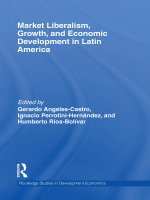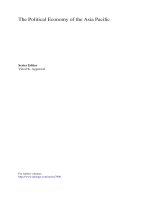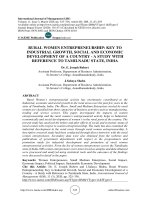Economic growth and economic development 399
Bạn đang xem bản rút gọn của tài liệu. Xem và tải ngay bản đầy đủ của tài liệu tại đây (122.51 KB, 1 trang )
Introduction to Modern Economic Growth
capital-labor ratio, consumption and output are constant. Therefore,
c˙ (t) = 0.
From (8.20), this implies that as long as f (k∗ ) > 0, irrespective of the exact utility
function, we must have a capital-labor ratio k∗ such that
(8.21)
f 0 (k ∗ ) = ρ + δ,
which is the equivalent of the steady-state relationship in the discrete-time optimal
growth model.2 This equation pins down the steady-state capital-labor ratio only as
a function of the production function, the discount rate and the depreciation rate.
This corresponds to the modified golden rule, rather than the golden rule we saw
in the Solow model (see Exercise 8.8). The modified golden rule involves a level of
the capital stock that does not maximize steady-state consumption, because earlier
consumption is preferred to later consumption. This is because of discounting, which
means that the objective is not to maximize steady-state consumption, but involves
giving a higher weight to earlier consumption.
Given k∗ , the steady-state consumption level is straightforward to determine as:
(8.22)
c∗ = f (k∗ ) − (n + δ)k∗ ,
which is similar to the consumption level in the basic Solow model. Moreover, given
Assumption 4’, a steady state where the capital-labor ratio and thus output are
constant necessarily satisfies the transversality condition.
This analysis therefore establishes:
Proposition 8.2. In the neoclassical growth model described above, with Assumptions 1, 2, 3 and 4’, the steady-state equilibrium capital-labor ratio, k∗ , is
uniquely determined by (8.21) and is independent of the utility function. The steadystate consumption per capita, c∗ , is given by (8.22).
As with the basic Solow growth model, there are also a number of straightforward
comparative static results that show how the steady-state values of capital-labor
2In addition, if f (0) = 0, there exists another, economically uninteresting steady state at
k = 0. As in Chapter 2, we ignore this steady state throughout. Moreover, we will see below that
starting with any k (0) > 0, the economy will always tend to the steady-state capital-labor ratio
k ∗ given by (8.21).
385









